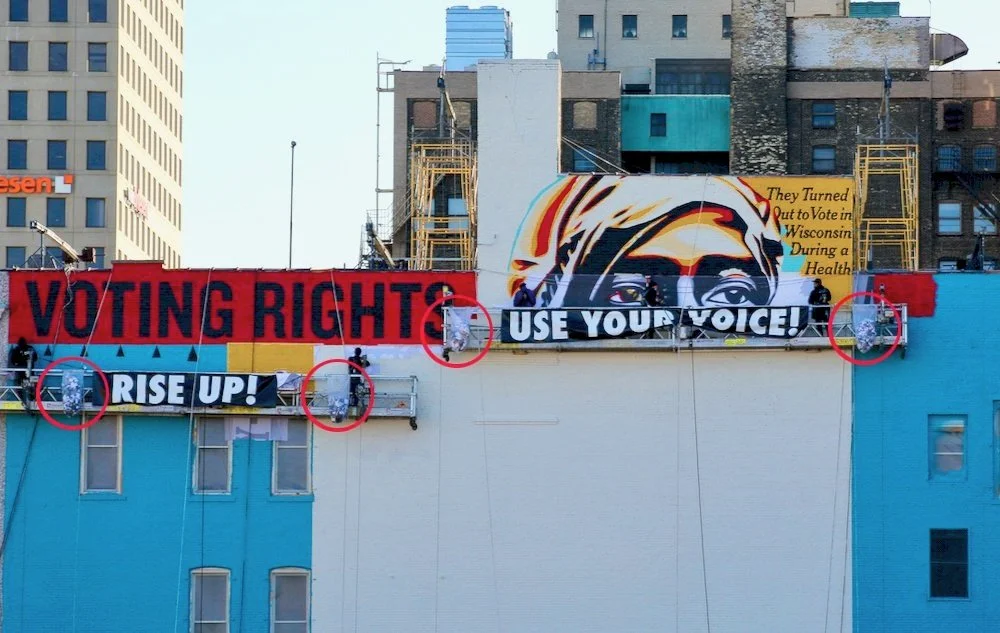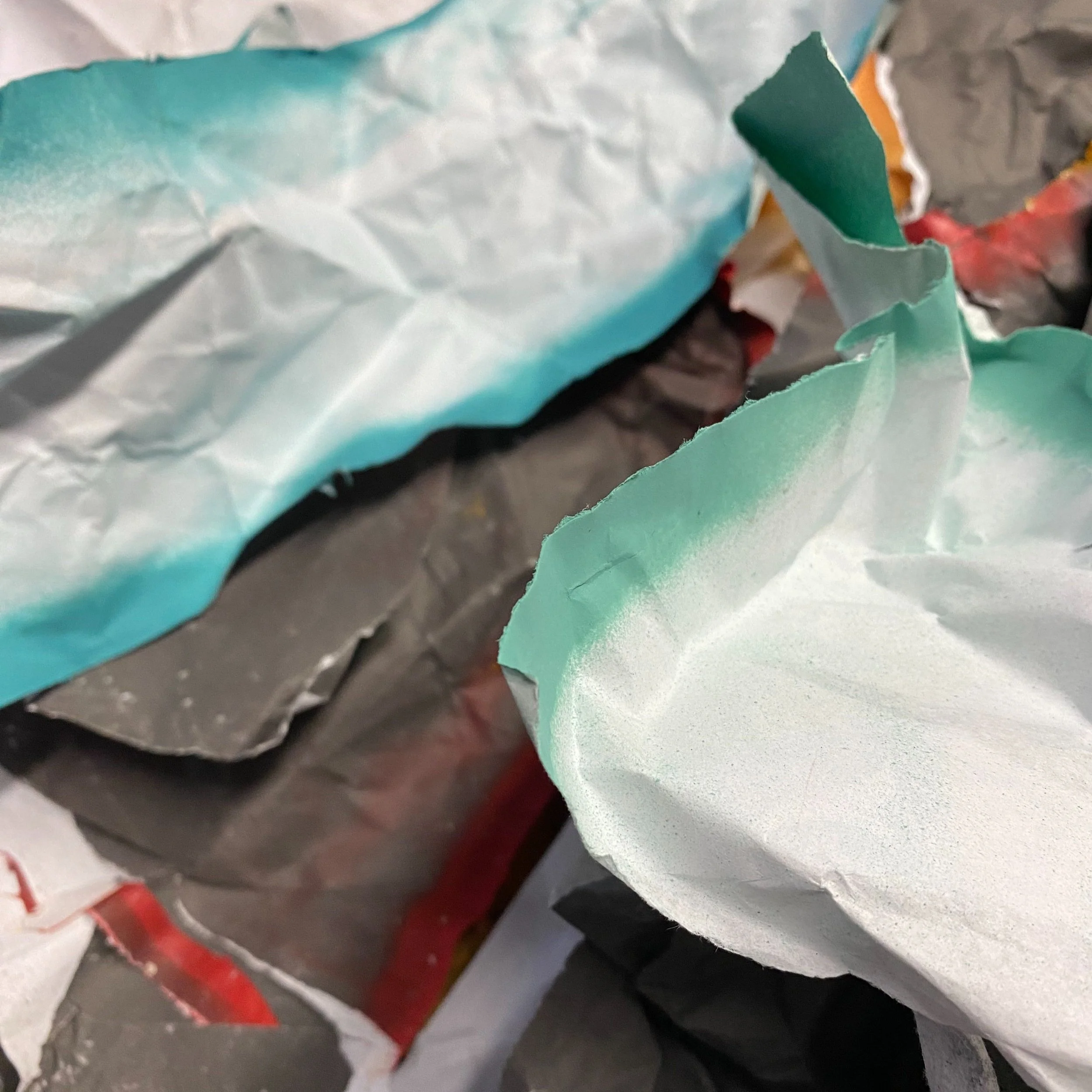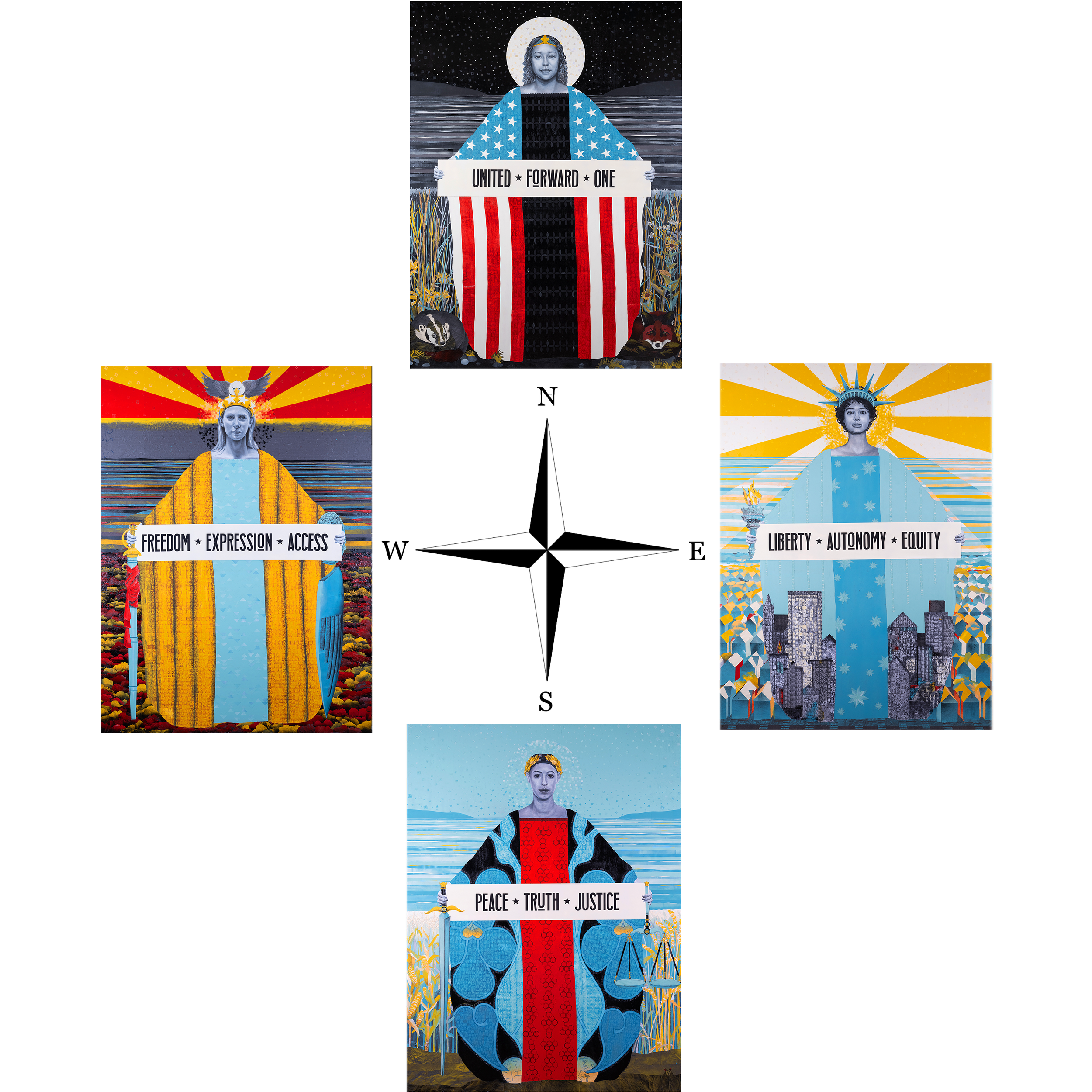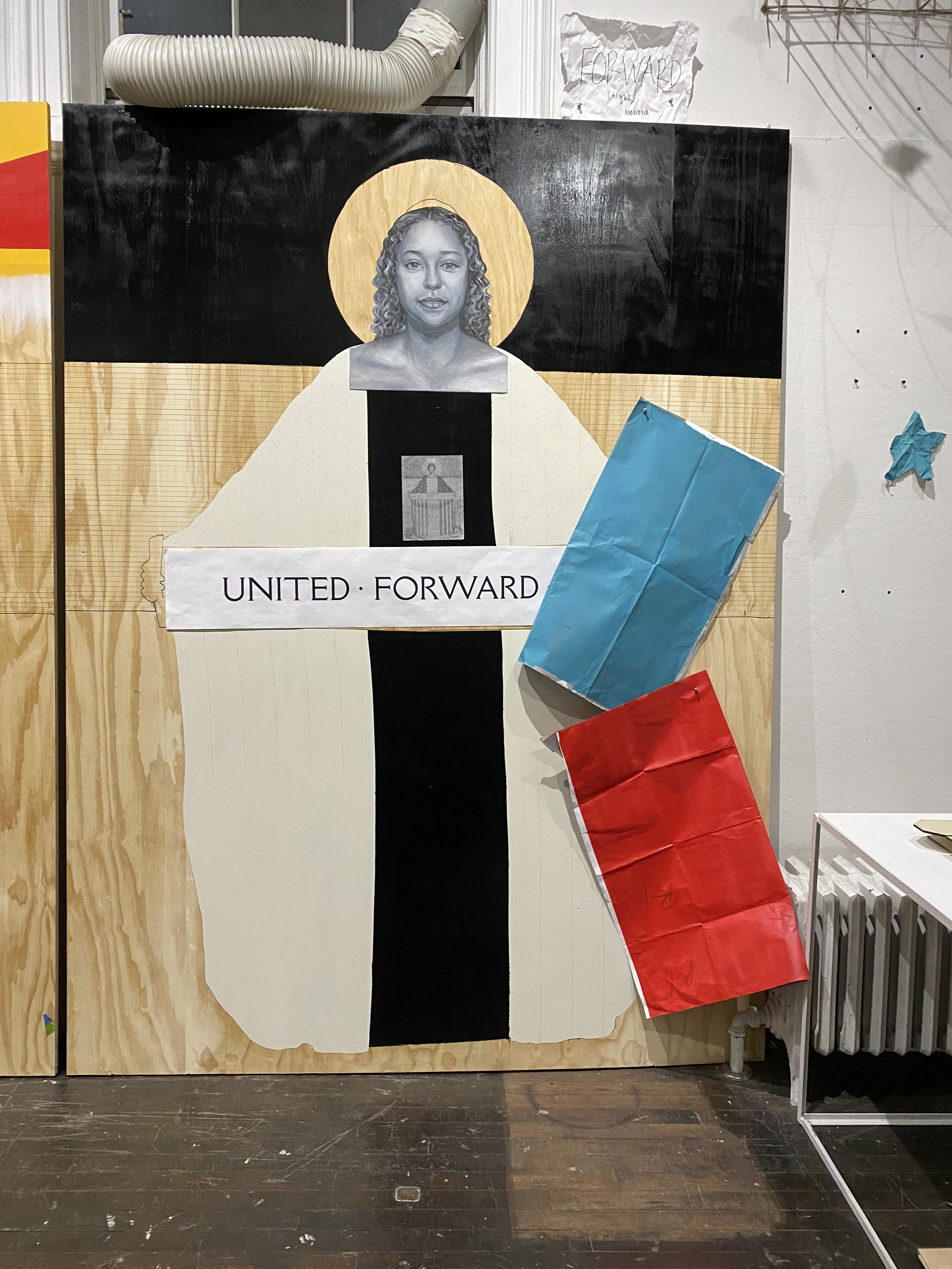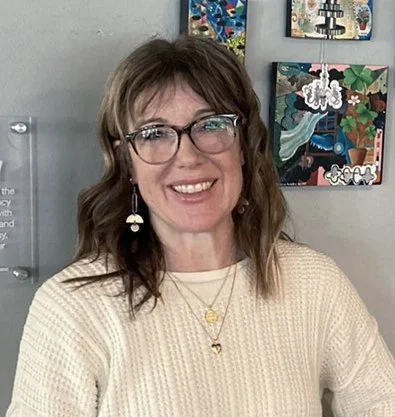Pillars of Democracy


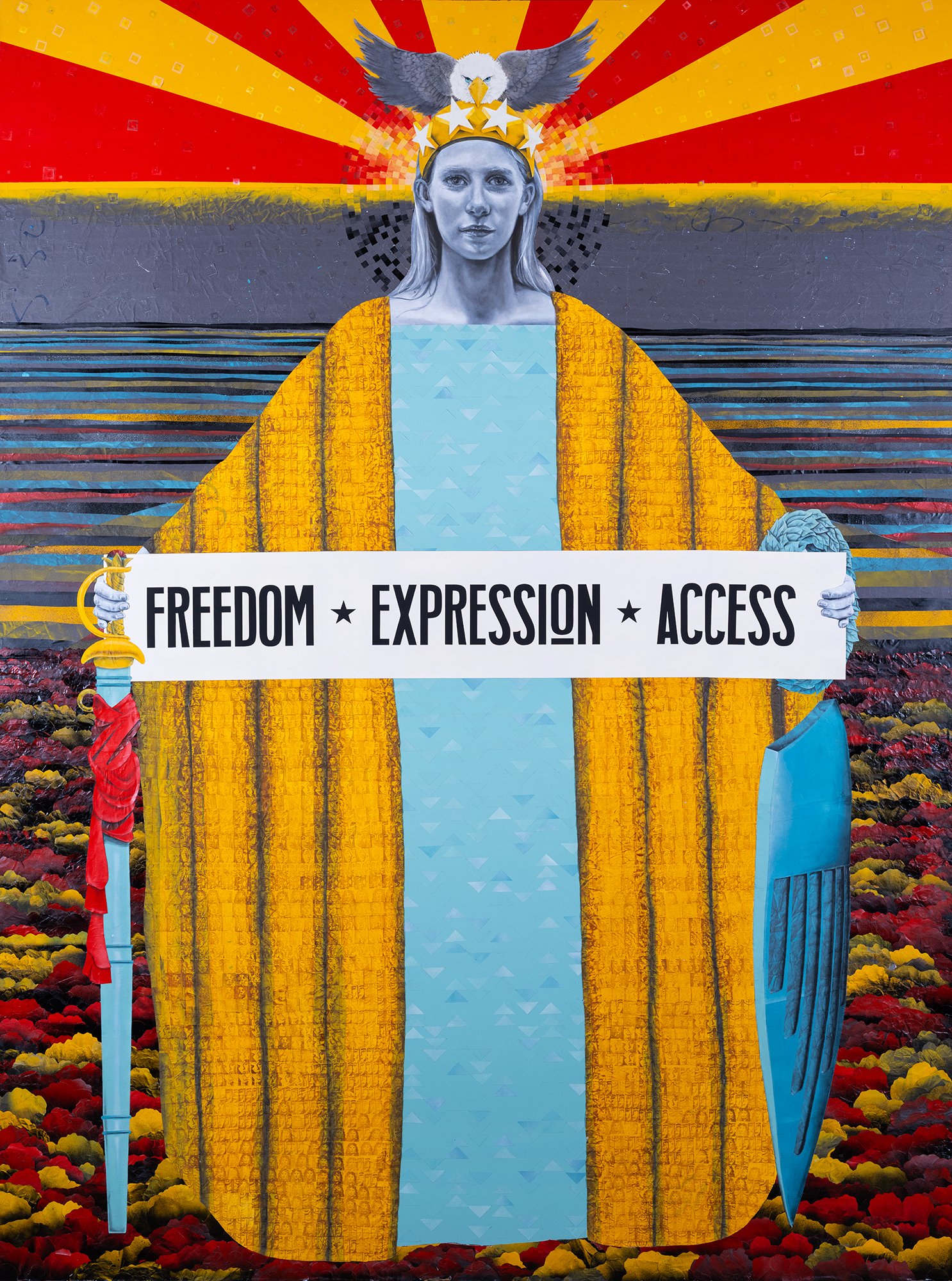
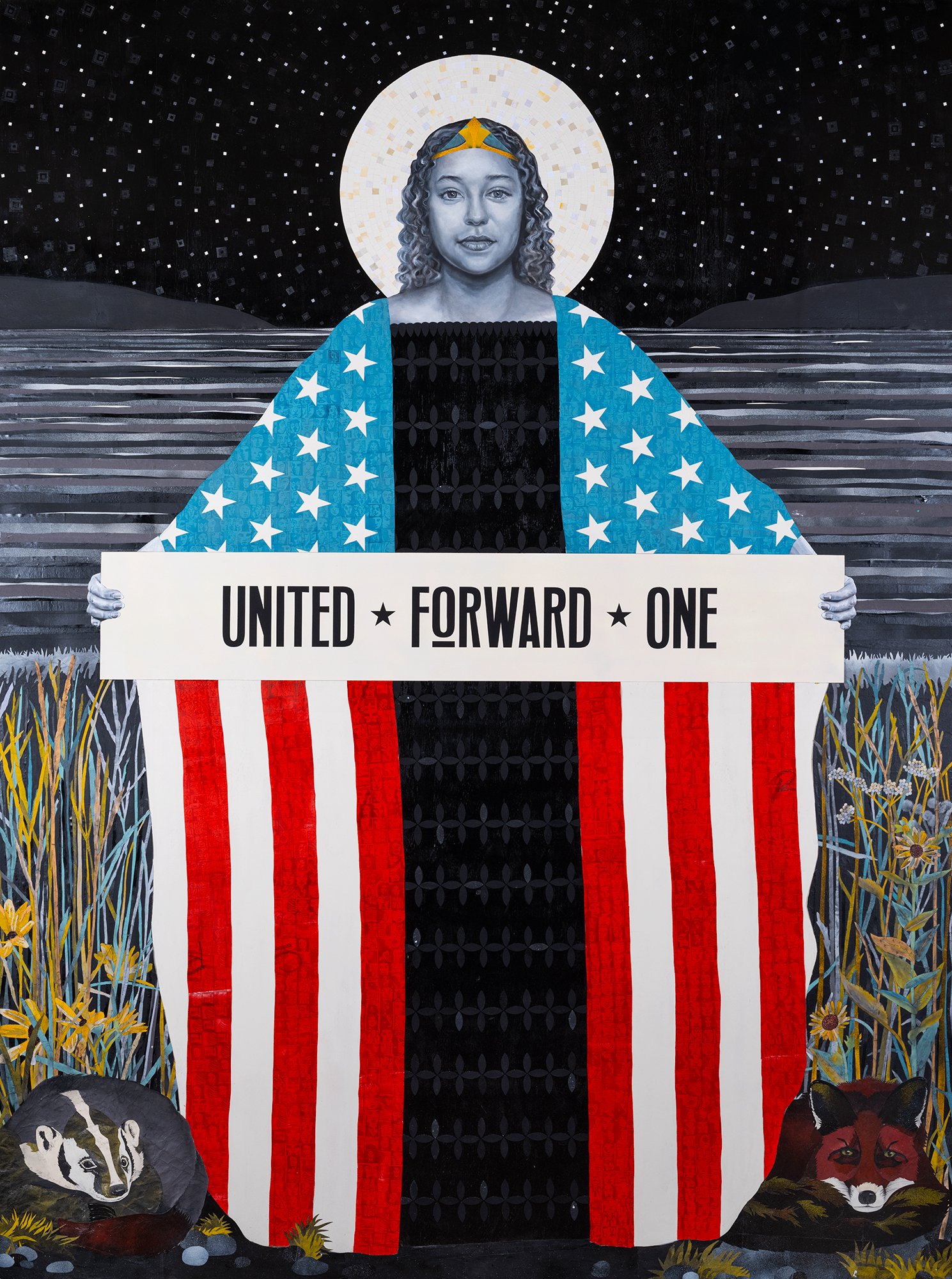
Pillars of Democracy is a four-part series of large-scale mixed media portraits that foreground the role of women in the democratic process. These works underscore the struggle inherent in political progress and the essential role artists play in movements for change. The allegorical figures—Liberty, Justice, Freedom, and Forward—are redrawn as first-time voters in Wisconsin. Grounded in the state’s diverse landscapes and progressive political legacy, each figure reflects how national values are lived, protected, and renewed at the local level.
Pillars of Democracy exists thanks to a community of people who believe in the power of civic action. Milwaukee artists: Lois Bielefeld, Nova Czarnecki, Celeste Contreras, Fran Korthof, Lizzy Lovas, Jill Sebastian, Brandom Terres-Sanchez, and Serena Weits contributed to the project. Nearly seventy volunteers from the League of Women Voters, PERSISTers, Girl Scouts, as well as friends old and new came to the studio to build art in solidarity over a ten month period. As lead artist, my role has been to design and build Pillars of Democracy while creating harmony between artistic contributions and generations of volunteers working in the studio.
Formally, the portraits draw on two powerful sources: a composition drawn from Bertha Boyd’s 1911 suffrage poster Votes for Women and the physical remnants from the installation of Shepard Fairey’s 2020 mural Voting Rights Are Human Rights. Built from discarded stencil paper and leftover spray paint, the works repurpose activist scrap materials into new icons of civic participation. The result is a layered visual dialogue between past and present—between suffrage-era design, contemporary protest, and the enduring power of the vote.
At its core, Pillars of Democracy declares that democracy is not abstract—it is built, sustained, and strengthened by each of us, right where we live. It lives in the choices we make and the values we uphold: liberty, autonomy, equity, peace, truth, justice, freedom, expression, access, unity, and an ever-present determination to move forward. This series honors voting as both inheritance and promise—a way to shape not only what we stand for, but where we’ve come from and who we dare to become.
The following writing covers the meaning and making of Pillars of Democracy.
Inception - Fall 2020
In October 2020, Shepard Fairey and the Obey Giant team installed a 7,400-square-foot mural titled Voting Rights Are Human Rights on the north wall of Milwaukee’s Colby Abbot building. At its center is a portrait of a young African American man—based on a 1960s civil rights march photo by Steve Schapiro—surrounded by artwork and imagery provided by five artists with ties to Wisconsin: Tom Jones, Dyani White Hawk, Tyanna Buie, Claudio Martinez, and me. Through collaborative dialogue and shared design drafts, our work was woven into a unified mural that spoke to the urgency of democracy and representation.
“Voting Rights Are Human Rights” by Shepard Fairey on the north wall of the Colby Abbot building in downtown Milwaukee, Wisconsin.
The Voting Rights are Human Rights mural was originally part of a national tour to support the 2020 election season. In a financial reaction to the COVID pandemic, the largest corporate sponsor had to withdraw, cancelling the tour; however, Fairey remained committed to installing the Milwaukee mural. Fairey stated, “The impetus for this project was rooted in activism and advocacy. Although the original pre-COVID funding of the project was stripped away due to the pandemic, it remains a goal of mine to work within the community of Milwaukee to lift up the urgent message of democracy and voting. We were able to get commitments for funding to cover the costs of travel and materials needed. I will donate my art, time and pay collaborators and my art team to work with me on painting the piece.”
“We are facing voter suppression in many places in the nation, but I especially wanted to address that issue with my mural in Wisconsin since voter suppression has been such a problem in the state,” Fairey noted.
Bags tied to scaffolding being loaded with scrap materials.
While supporting the mural team on-site, my eyes were drawn to the bags tied to the scaffolding being filled with discarded stencil paper and spray cans. Technically trash bags, their content felt anything but inert. The remnants carried a residual potential, infused with the labor of the team, the intention of the mural and the outcome of a major election.
As the install wrapped up, I asked the team if I could take the bags. I explained that I’m a bit of a coyote when it comes to scavenging materials, and that I felt their contents held potential for new work. I said I’d be in touch if the right idea surfaced. I was told to go for it, and then was warned to watch out for razor blades. So that winter, I put on a pair of thick rubber gloves and sorted their contents-- tossing trash and razor blades, holding onto all of the paper and spray cans.
Envisioning a better nation - Summer 2024
In August 2024, I had the honor of exhibiting my works Hills & Valleys and Justice in Repose (RBG) as part of INTO ACTION 2024—a national pro-democracy exhibition held during the Democratic National Convention in Chicago. Billed as a festival of art and ideas, INTO ACTION highlighted the power of voting through bold, thought-provoking work by over 120 visual artists from across the country. The weeklong event unfolded in a 9,000-square-foot gallery space and featured more than 20 hours of programming, including film screenings, performances, and conversations with political leaders, youth activists, filmmakers and fellow artists. Free and open to all 18 and older, the space served as a vibrant hub for dialogue, creativity, and civic engagement.
It was an incredible experience to exhibit among so many of my art heroes and work with Yosi Sergent and Evan Cerasoli through the run of the show. They provided a 33’ wall for my work right in the center of the exhibition space next to a large display of Michelle Pred’s activist handbags, around the corner from Shepard Fairey’s pieces, prints by Milwaukee artist John Fleissner, a large wall piece by Swoon, prints by For Freedoms, photos by Whitney Bradshaw and so many many more. From the other exhibiting artists, to the curatorial team, to the installation crew to the wildly receptive audience-- it was incredible to witness the conversation our combined efforts created.
I joined a cohort of cultural producers from swing states, brought together by INTO ACTION 2024 for a few days of focused dialogue during the run of the event. Our goal: to share perspectives on the political climate in our communities and explore creative ways to inspire voter engagement ahead of the election. The group was a dynamic mix of DJs, rappers, tattoo artists, curators, community organizers, and artists. Though the programming was loosely structured, the energy was undeniable. Around every table, ideas were buzzing—strategies for voter registration, outreach, and mobilization were taking shape in real time.
We shared meals, drinks, and stories. We walked the streets of Chicago and caught cabs across the city, talking, listening, and learning from each other. We left with a clear charge: return home, connect deeply, and engage our communities in bold, imaginative ways—to get people registered, inspired, and ready to vote.
The vision for Pillars of Democracy came to me during that powerful week in Chicago. Between the artworks on the walls, dialogue between activists and audiences, and engagement of the community that came to participate in it all, I saw democracy embodied not in monuments or mottos, but as first-time voters. Lady Liberty, Justice, Freedom and Forward progress became living pillars—united and empowered as everyday women in Wisconsin.
Materials & Design - fall 2024
For those unfamiliar with my work, I create art that engages themes of identity and equity, with the intention of interrogating the structural power systems that shape contemporary life. Grounded in feminist perspectives, my practice aims to create space for critical reflection and hopefully ignite renewed commitments to social justice and collective responsibility within my audience.
I am more aware now than ever of how fragile personal freedom can be—especially in the face of rising fascism and the encroachment of conservative religious doctrine in public life across the United States. I speak from the vantage point of someone who claims full membership in American society—whose bodily autonomy, identity, and freedom are not up for debate. Through my art, I process both the disenchantment I feel and the hope I continue to hold for this nation. Art is both my teacher and my voice.
Much of my artwork is composed of hundreds—sometimes thousands—of individual parts, often requiring hundreds of hours to complete. I see each piece as an evolution of thought, where the time spent making is essential for a full synthesis of concept and material. Meaning in my artwork emerges through the deliberate pairing of my own intentions with the cultural significance embedded in the materials I use.
In my art, materials are not passive elements; they carry memory, presence, and emotional resonance. Much of my time in the studio involves working in a liminal space—pre-language, pre-narrative—where meaning is felt before it can be fully articulated. I see my role as an artist as being a steward, channeling the affective quality of materials from one context to another, reshaping their meaning through reuse.
Stencil paper with overspray edges.
The cultural significance of the scrap materials from the installation of Voting Rights Are Human Rights—mostly torn paper, paint-stained and marked by paint splatter or grid coordinates scrawled in ink—hold traces of the mural’s creation. They are physical remnants of action—proof that something was made with urgency, purpose, and collective intent.
Aesthetically, the layered spray paint, cut edges, and smudges evoke immediacy and labor. The scrap speaks to hands at work, of bodies traversing scaffolding, during the week in October 2020 when this image was painted into the public sphere with determination. The materials hold echoes of the political messages they shaped—justice, resistance, solidarity. Their power comes from being byproducts of activism, and carries its residue.
When integrated into a new artwork, these materials maintain connection to their origin, inviting viewers to imagine both the shared labor of Obey Giant installing the mural in 2020, as well the community of artists and volunteers building the portraits of Liberty, Justice, Freedom and Forward from 2024 to 2025. The materials become artifacts: not polished, but tactile memory. By preserving and repurposing materials in an artwork, their meaning is amplified, transforming what was once a utilitarian tool into a layered meaning within new art.
When composing Pillars of Democracy, I was drawn to the clarity and elegant simplicity of Bertha Boyd’s iconic 1911 suffrage poster titled Votes for Women, and decided to incorporate the format into my designs.
In Votes for Women, Boyd’s figure stands before the San Francisco Bay with the sun behind her, forming a halo around her head. She holds a banner that reads with assertive clarity. This design reflects the organized nature of the suffrage movement—its message is direct, uncluttered, and urgent. This imagery aimed to normalize the idea of women voting, project unity, and spark curiosity and conversation. In 1911, voting rights were being fought state by state, and posters like Boyd’s were essential tools for mobilizing support, advertising events, and claiming public space for women’s voices—even though the artist herself had not yet been granted the right to vote.
When drawing the preliminary sketches for Pillars of Democracy, I knew the figures of Liberty, Justice, Freedom, and Forward needed to be pictured in Wisconsin, as this state holds a unique legacy of progressive firsts that continue to shape our national identity. Each figure was intentionally placed in a specific Wisconsin landscape to reflect both the natural diversity of the region and the spirit of democratic action rooted here:
Liberty rises at dawn in Milwaukee, Lake Michigan behind her and the city’s skyline woven across her robe—symbolizing the awakening of civic power in our urban centers.
Justice stands in the light of midday at Lake Winnebago, her robe patterned with woodland violets, flanked by fields of wheat and corn—honoring the balance of labor, equity, and growth in our agricultural heartland.
Freedom, cloaked in fur, hovers at dusk above the deep waters of Lake Superior and the surrounding northern forests—echoing the resilience and endurance of people and place.
Forward glows at night on the shores of Lake Monona, draped in an American flag, encircled by native flora and fauna—guiding us into the future with care for both democracy and the environment.
These icons of democracy belong in Wisconsin because this state has long served as a testing ground for progress. It was the first to ratify the 19th Amendment granting women the right to vote, the first to pass an unemployment compensation law, the first to establish a statewide gay rights law, and the first to elect an openly gay Congresswoman. And today, Wisconsin continues that legacy by electing a second Supreme Court Justice in a row committed to fair maps and reproductive justice. These actions shine as a beacon of hope in a time of deep uncertainty—proof that, even now, Wisconsin is lighting the way forward for the rest of the nation.
Living Icons - Voters in America Today
Liberty, Justice, Freedom, and Forward progress are concepts historically personified as women in political symbolism worldwide—figures draped in allegory, often distant and idealized. But what happens when we ground those ideals in real people, in our neighbors, in our community?
By portraying four women living in the Milwaukee area as living embodiments of liberty, justice, freedom and forward, the work invites viewers to recognize those same values within themselves. The dichotomy between the sentiment of these symbolic figures and the lived experience of everyday women is bridged, reflecting that the future of our democracy begins here, in the communities we know, with the people around us.
First-time voters hold the key to our future. Their participation in the democratic process marks both a personal milestone and a collective step forward. To find first-time voters for this project, I reached out to my network of friends and soon met Lola, Becca, Anna, and Courtney. They were the first four to respond to my call.
After photographing and getting to know each of them a bit better, I chose who would represent each figure based on what they shared about their lives, their families, and their personal aspirations.
Liberty is represented by Lola, who had immigrated to the U.S. with her family three years before. She’s the youngest in her family, a talented illustrator, and just completed her freshman year at Marquette University, where she’s studying environmental engineering. Her ambition and creativity, paired with her experience of navigating a new country, reflect the dynamic possibilities of liberty in action.
Justice is embodied by Becca, whose grandparents came to the U.S. as migrant farmworkers, eventually settling in Wisconsin to raise their family. Becca now works as a bartender and house painter, raising her young son with her fiancé. She’s also passionate about advocating for girls with Alopecia, offering confidence and solidarity drawn from her own experience. Her story speaks to both generational resilience and a deep personal commitment to justice and representation.
Freedom is represented by Anna, a recent graduate of Shorewood High School and a standout athlete in track and field. Her strength, discipline, and ability to overcome setbacks made her a natural choice to represent this pillar.
Forward is embodied by Courtney, the valedictorian of Saint Francis High School’s graduating class of 2025. Headed to Cornell University on a full scholarship this fall, Coutney’s drive and academic success symbolize the forward motion championed by Americans in the past, present and future.
Together, these women transform the traditional, often mythologized images of Liberty, Justice, Freedom, and Forward into something more grounded and urgent. They are not distant goddesses but real people living in Wisconsin—iconic in their own right. In this way, the Pillars of Democracy becomes both a modern-day allegory and a powerful reminder that national values are built by real people at the local level everyday.
Democracy as ART - Art As Action
By combining the format of Bertha Boyd’s 1911 suffrage poster with materials salvaged from Shepard Fairey’s Voting Rights Are Human Rights mural, Pillars of Democracy creates a layered dialogue between past and present—bridging more than a century of voting rights activism. This fusion of historic form and contemporary material is a visual and conceptual conversation across time, reminding us that the fight for democracy is ongoing, cumulative, and collective.
Pillars of Democracy highlights the essential role of women in shaping American democracy. Boyd’s original poster was a tool of political mobilization, wheat-pasted in shop windows, train stations, and meeting halls to spark dialogue and galvanize support. By weaving together historic imagery, contemporary activist materials, and the contributions of Milwaukee-area artists, Pillars of Democracy becomes both witness and participant in an evolving civic story—one defined by community, shared effort, and forward motion. From suffragists in the early 20th century to first-time voters in 2024, this project links actions of resistance to reflect the truth that democracy is not static. It is shaped by those who show up, speak out, and most importantly—vote.
Pillars of Democracy forms a compass rose when the figures are displayed following the path of the sun, illuminating Liberty at sunrise to the east, Justice to the south beneath the midday sun, Freedom to the west backlit by the sun at dusk, and Forward to the north in the light of the moon. As each figure features the portrait of a first-time voter, the defining values that guide our nation point to voting as the action we all must take to navigate this democracy towards a better future.
Teamwork: Artists, Volunteers & Voters


















The first major group effort was unwrapping and flattening paper from bags of mural scrap, which was no small task. The stencil paper had been fixed to the side of the Colby Abbot building with a spray adhesive, and then crumpled into balls before being tossed into the bags. Those bags were then stored in an unfinished attic space for four years, which made for some very tricky paper to unfold. But once volunteers found rhythm, the studio began to hum. As materials were unwrapped and sorted by color, the contributing artists picked out what they needed—either working onsite, or in their own studios to create their contributions for the portraits.
I constructed the six-foot by eight-foot panels out of ¾” plywood, mapped out the compositions, met with artists, and photographed the first-time voters before experimenting with paper. My first version of Liberty’s robe—made from edges of overspray—was scrapped, along with the first draft of sun rays. Experimenting with the overspray edges of color eventually led to testing the leftover spray cans to see if the paint was still good, and then emptying the remaining paint directly on panels or paper to introduce full color fills and gradients pulled directly from the source materials.
As the work progressed, the community kept growing. In early December when temperatures peaked above 50 degrees, volunteers joined me outdoors to spray base layers. By early February, the project moved to the unfinished second floor at our house. The League of Women Voters from the Milwaukee County and Ozaukee/Washington chapters—became a regular presence, sometimes bringing up to twelve volunteers at a time. The Girl Scouts joined in too— and Troop 10543 even earned their Democracy badges while building the night sky for Freedom. So very cool.
We adjusted constantly. Elements were created, reconsidered, and rebuilt. Robes were assembled and reassembled. Dresses sanded off and repainted. Backgrounds reworked. Water re-patterned. Color and shadows adjusted. The process was both iterative and improvisational, shaped by the delicate relationship between figure and background; between one portrait and all four together. The artists remained flexible and dedicated. The volunteers brought insight, humor and so many hours of production. In the final weeks, the PERSISTers joined the buildout, widening the circle of support even further.
At every stage, this was a project built by the community. The layered contributions—of artists, activists, students, neighbors, new voters and poll workers—brought this project so much depth and momentum. I’m truly grateful to all who trusted and believed in the process and helped carry it forward.
Contributing Artists
Lois Bielefeld
Lois Bielefeld is a contemporary photographer and multidisciplinary artist based in Milwaukee, Wisconsin. Their work blends fine art photography, video, audio, and installation, often focusing on themes of identity, ritual, family, queerness, and the complexity of everyday life. Through thoughtful, often intimate visual storytelling, Bielefeld invites viewers to consider how people shape—and are shaped by—their surroundings, relationships, and personal routines.
Since last September, Lois has teamed up with me to document the making of Pillars of Democracy through photography and video, expanding the visual record of the project as it took shape in the studio.
Celeste Contreras
Celeste Contreras is a Xicana - Indigenous artist who works in mixed mediums to share stories of ceremony, culture and tradition. Her work includes illustrations, print, book arts and animation. Her research includes the history of storytelling through images and objects, exploring the condition of the book and book form and recalling the palimpsests of intergenerational trauma from migration, genocide of culture to relearning, and decolonizing through ceremony.
Celeste’s block prints, featuring miniature portraits and ceremonial iconography, are embedded in each figure’s robe: forming the Milwaukee skyline on Liberty, evoking fabric on the figures of Justice and Forward, and creating fur-like textures for Freedom’s robe.
Nova Czarnecki
Nova Czarnecki is a contemporary American artist known for creating richly layered, symbolic, and often surreal figurative paintings. Her paintings blend elements of mythology, nature, feminism, and identity, rendered in a style that merges realism with dreamlike abstraction. Full of metaphorical content, with recurring themes like rebirth, cycles, or transformation, her figures and settings frequently seem to exist outside of linear time—evoking dream states or ancient archetypes. Nature is omnipresent and interwoven with the human form. She paints mostly in oil on canvas or panel, using a palette that ranges from muted natural tones to vibrant, saturated hues, depending on the emotional or narrative quality of the work.
Nova created detailed oil paintings of each figure’s face and hands, working from photographs of the four first-time voters featured in Pillars of Democracy. Once complete, the painted elements were carefully trimmed from their original canvases, and collaged into the larger mixed media portraits—bringing realism, warmth, and individuality to each figure.
Fran Korthof
Fran Korthof is an artist, activist and retired public school art teacher from the Elmbrook School District in Wisconsin. Over her thirty-year teaching career, Korthof encouraged creative exploration and individual expression in her students, helping them to balance technical skill-building with open-ended projects. Korthof currently volunteers at Art Links 333, a hub for creative expression and community engagement for adults with disabilities, and is a former board member and chair of Artful Bowls - and a major fundraiser for the organization.
Fran came to the studio to volunteer, and took the challenges of this project to another level. She became the lead artist creating elaborate paper collage pieces for Brandom Terres- Sanchez’s final drawings.
Lizzy Lovas
Lizzy Lovas is a Senior Art Director at Kohl’s, who creates work that balances strategic visual storytelling with a strong sense of aesthetic intuition and cultural awareness. Her portfolio spans branding, editorial design, advertising, and creative direction— often for clients in sectors like fashion, arts, publishing, and wellness. Lovas wears many hats, but her favorites are hand lettering, logo design, layout, and book design.
Lizzy contributed type to the banners each figure holds in Pillars of Democracy, which reads with clarity uniting 100+ years of activist print.
Jill Sebastian
Jill Sebastian is a renowned American visual artist, sculptor, public art designer, and educator based in Milwaukee, Wisconsin. Her practice spans sculpture, installation, conceptual art, and public space design. She is known for blurring the boundaries between art, architecture, landscape, and social practice. Jill Sebastian’s work is often site-specific and deeply responsive to place and context. It combines conceptual rigor with accessibility and invites participation. Her public installations frequently blend formal design with poetic inquiry, balancing functionality and symbolism.
Jill generously provided her studio for the initial buildout of this project and for the first half of production. Her contributions can be seen in the backgrounds of each portrait, including the collaged neighborhoods, agricultural fields, forest and flora surrounding each figure.
BRANDOM TERRES-Sanchez
Brandom Terres-Sanchez is a Mexican-American artist originally from Las Vegas, Nevada currently living in Milwaukee, Wisconsin. Their paintings are often paired with audio, found objects, and installation to create an immersive experience that encapsulates a concept of “home”. Their work explores our personal connections to home but also to feelings of distance within close relationships, home and artist. An emerging artist in the Milwaukee area, Terres-Sanchez’s art has been shown in spaces like Var Gallery, Walker Point Center for the Arts, and the Trout Museum.
Brandom supplied multiple drafts of each figure’s crown and accompanying gear (swords, shield, scales, animals), which were then translated into paper collage. Once the collage work was complete, Brandom added linework and shading to bring dimension, highlights and shadows to each element.
SERENA WEITS
Serena Weits is an artist and photo stylist known for crafting visually striking, emotionally engaging imagery across editorial, commercial, and fine art contexts. Her artwork includes painting, collage, and installation and often involves layering found materials to create texture and meaning. Her process is guided by emotion, the seasons, and her surroundings.
Serena supported Pillars of Democracy by laying out the quilt patterns on each figure’s dress just a few weeks before the project wrapped. Her signature celestial design is referenced in the layout of the star pattern on Liberty’s dress.


